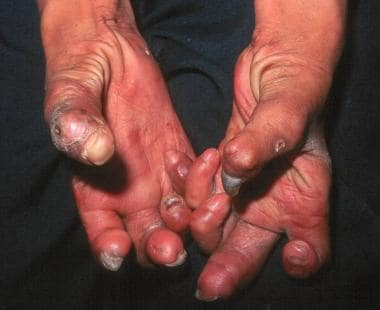Background
Leprosy is a chronic infection caused by the acid-fast, rod-shaped bacillus Mycobacterium leprae. Leprosy can be considered 2 connected diseases that primarily affect superficial tissues, especially the skin and peripheral nerves. Leprosy is suspected to be transmitted via droplets from the nose and mouth after prolonged close contact with someone. [1] Initially, a mycobacterial infection causes a wide array of cellular immune responses. These immunologic events elicit the second part of the disease, peripheral neuropathy, with potentially long-term consequences.
The social and psychological effects of leprosy and its highly visible debilities and sequelae (as seen in the image below) have resulted in a historical stigma associated with leprosy. To minimize the prejudice against those with leprosy, the condition is also known as Hansen disease, named after G.A. Hansen, who is credited with the 1873 discovery of M leprae. This mycobacterium grows extremely slowly but has been successfully cultured in vitro using Dubos-Lowenstein-Jensen medium and thyroxine sodium. [2]
 Hands with Z-thumbs, clawing, contractures, and shortening of fingers due to repetitive injury and healing. Ho Chi Minh City, Vietnam. Courtesy of D. Scott Smith, MD.
Hands with Z-thumbs, clawing, contractures, and shortening of fingers due to repetitive injury and healing. Ho Chi Minh City, Vietnam. Courtesy of D. Scott Smith, MD.
In the 1990s, the World Health Organization (WHO) launched a campaign to eliminate leprosy as a public health problem by 2000. Elimination, as defined by the WHO, meant a reduction of patients with leprosy requiring multidrug therapy to fewer than 1 per 10,000 population.
-
Hands with Z-thumbs, clawing, contractures, and shortening of fingers due to repetitive injury and healing. Ho Chi Minh City, Vietnam. Courtesy of D. Scott Smith, MD.
-
Patient with facial nerve palsy and contractures of the hand. Daloa, Ivory Coast. Courtesy of D. Scott Smith, MD.
-
Chronic insensate patch due to leprosy infection. Ho Chi Minh City, Vietnam. Courtesy of D. Scott Smith, MD.
-
Characteristic clawed hand deformity caused by ulnar involvement in leprosy. Daloa, Ivory Coast. Courtesy of D. Scott Smith, MD.
-
Chronic nonhealing ulcer at the metatarsal head resulting from loss of sensation in the feet. Karigiri, Tamil Nadu, India. Courtesy of Tara Ramachandra.
-
Multiple flat hypopigmented lesions on shoulder and neck, suggestive of multibacillary leprosy. Note ulceration of hypothenar area of hand, indicative of sensory loss with curled 5th digit, from ulnar neuropathy. Redwood City, California, United States. Courtesy of D. Scott Smith, MD.
-
Man with advanced deformities caused by unmanaged leprosy. Keratitis, loss of eyebrow, thickened skin, and typical hand impairments. Ho Chi Minh City, Vietnam. Courtesy of D. Scott Smith, MD.
-
Histopathology of leprosy: Large numbers of acid-fast bacilli (in clusters) in histiocytes and within nerves. Fite-Faraco stain 500 X. Courtesy of Tara Ramachandra, MD, and D. Scott Smith, MD.
-
Patient with multibacillary leprosy showing subsequent erythema nodosum leprosum reaction. Santa Clara, California. Courtesy of D. Scott Smith, MD.
-
Patient with erythema nodosum leprosum type 2 reaction several weeks after initiation of drug therapy. This photograph was taken after tendon release. Redwood City, California. Courtesy of D. Scott Smith, MD.
-
Increased pigmentation on the face due to clofazimine therapy. Courtesy of D. Scott Smith, MD.
-
2018 leprosy treatment guidelines. Courtesy of the WHO.
-
Map of countries reporting rifampicin resistance in leprosy between 2009 and 2015. Courtesy of the WHO.
-
2018 WHO guidelines for treatment of drug-resistant leprosy. Courtesy of the WHO.
-
2018 guidelines for single-dose rifampicin. Courtesy of the WHO.
-
WHO map showing new cases of new leprosy cases, 2020. Courtesy of the WHO.







